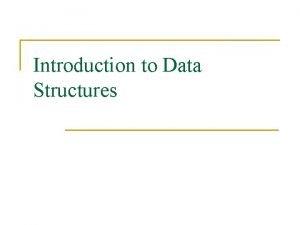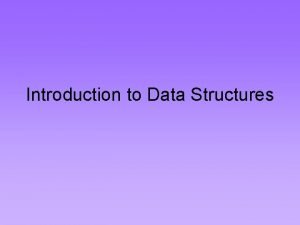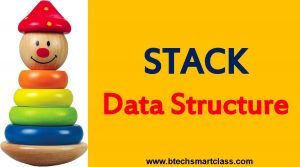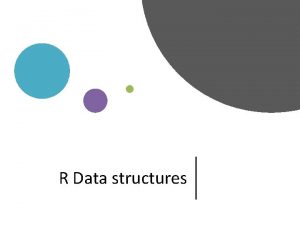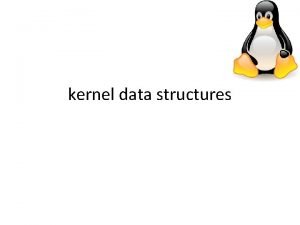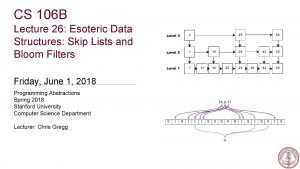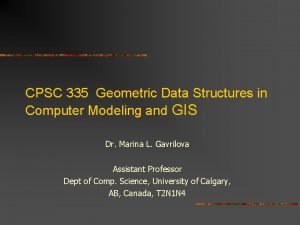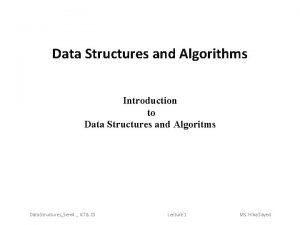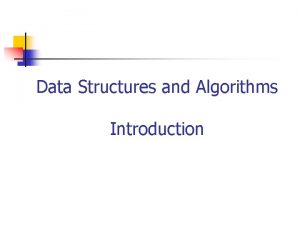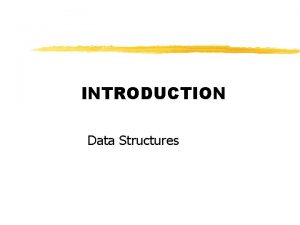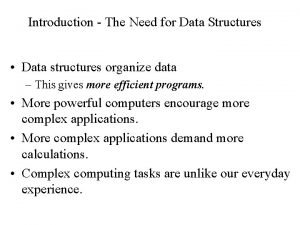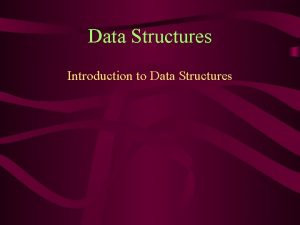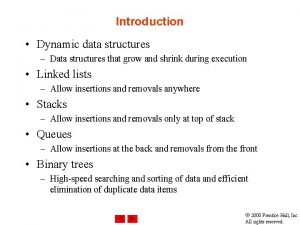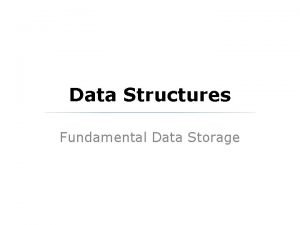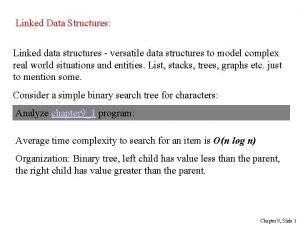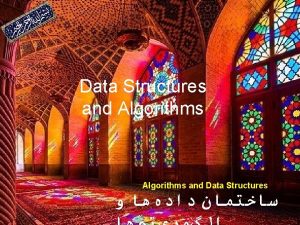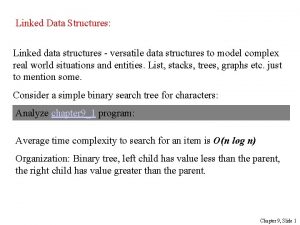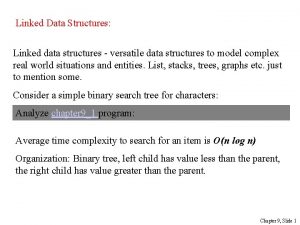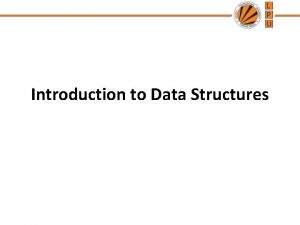Introduction to Data Structures Data Structures n A

















- Slides: 17

Introduction to Data Structures

Data Structures n. A data structure is a scheme for organizing data in the memory of a computer. n. Some of the more commonly used data structures include lists, arrays, stacks, queues, heaps, trees, and graphs.

Example: A Queue A queue is an example of commonly used simple data structure. A queue has beginning and end, called the front and back of the queue. Data enters the queue at one end and leaves at the other. Because of this, data exits the queue in the same order in which it enters the queue, like people in a checkout line at a supermarket.

Example: A Binary Tree A binary tree is another commonly used data structure. It is organized like an upside down tree. Each spot on the tree, called a node, holds an item of data along with a left pointer and a right pointer. Binary Tree

Example: A Binary Tree The pointers are lined up so that the structure forms the upside down tree, with a single node at the top, called the root node, and branches increasing on the left and right as you go down the tree. Binary Tree

Choosing Data Structures By comparing the queue with the binary tree, you can see how the structure of the data affects what can be done efficiently with the data.

Choosing Data Structures A queue is a good data structure to use for storing things that need to be kept in order, such as a set of documents waiting to be printed on a network printer. .

Choosing Data Structures The jobs will be printed in the order in which they are received. Most network print servers maintain such a print queue. .

Choosing Data Structures A binary tree is a good data structure to use for searching sorted data. The middle item from the list is stored in the root node, with lesser items to the left and greater items to the right.

Choosing Data Structures A search begins at the root. The computer either find the data, or moves left or right, depending on the value for which you are searching. Each move down the tree cuts the remaining data in half.

Choosing Data Structures Items can be located very quickly in a tree. Telephone directory assistance information is stored in a tree, so that a name and phone number can be found quickly.

Selecting a Data Structure n n n Analyze the problem to determine the resource constraints a solution must met. Determine basic operations that must be supported. Quantify the resource constraints for each problem. Select the data structure that meets this requirements.

Choosing Data Structures For some applications, a queue is the best data structure to use. For others, a binary tree is better. Programmers choose from among many data structures based on how the data will be used by the program.

Basic Terminology n n n Data: are simply values or sets of values. Data Type A data type is a collection of objects along with a set of operations. Abstract Data Type An ADT is a data type that is organized in such a way that the specification of the objects and the operations on the objects is separated from the representation of the objects and the implementation of the operations.

Linear and Non-Linear Data structures n n A data structure is said to be linear if its, elements form a sequence or a linear list. Ex: list, linked list, arrays, stacks, queues etc In Non-linear data structure every data item is attached to several other data items in a way that is specific for reflecting relationships. The data items are not arranged in a sequential structure. Ex: Trees, Graphs

Representation of Linear Data structures in Memory n n n to have the linear relationship between the elements by means of sequential memory locations. Such linear structures are called arrays. to have the linear relationship between the elements represented by means of links. Such linear data structures are called linked list.

Data Structure Operations n n n Traversing Searching Inserting Deleting Sorting Merging
 Introduction to data structures
Introduction to data structures Introduction to data structures
Introduction to data structures Example of homologous structure
Example of homologous structure Introduction to data mining and data warehousing
Introduction to data mining and data warehousing Intro paragraph layout
Intro paragraph layout Btechsmartclass c
Btechsmartclass c Types of data structures in r
Types of data structures in r Oblivious data structures
Oblivious data structures Linux kernel map data structure
Linux kernel map data structure Ajit diwan iit bombay
Ajit diwan iit bombay Esoteric data structures
Esoteric data structures Geometric data structures
Geometric data structures Cos 423 princeton
Cos 423 princeton Data structures and algorithms tutorial
Data structures and algorithms tutorial Performing file i/o using hdfs
Performing file i/o using hdfs Macro call is handled in this pass of macro processor
Macro call is handled in this pass of macro processor Advanced data structures in java
Advanced data structures in java Assembler algorithm and data structures
Assembler algorithm and data structures
